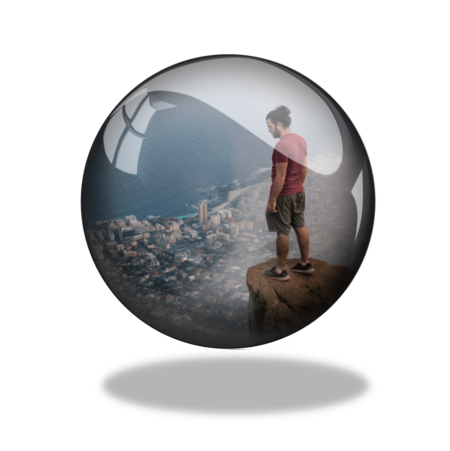Use Practice Zones to develop skills and insights in people ahead of when they are needed. This helps build competence and confidence ahead of taking on new roles and challenges and reduces performance anxiety at work. This article is part of our series on stress resilience and mental health at work..
– – – – – – – – – – – – – – – – – – – –
The challenge of everything having consequences
Performance anxiety at work is perhaps the epitome of workplace stress. It occurs when we need to perform at a particular level and we are not fully confident that we can. Perhaps it is a new challenge. Maybe we talked our capabilities up in securing the opportunity to face that challenge. Or maybe we feel we may be on our ‘third strike’ – metaphorically, or literally.
 We feel a bit under the microscope of dispassionate (even unfriendly) eyes. And we cannot drop the ball. Perhaps doing so has real consequences for our career, or our job security, or our reputation and influence.
We feel a bit under the microscope of dispassionate (even unfriendly) eyes. And we cannot drop the ball. Perhaps doing so has real consequences for our career, or our job security, or our reputation and influence.And we feel this high level of stress as a churning inside of us.
our body, our minds, and our skin are telling us they would rather be somewhere else
Some people thrive on this feeling, even at this level of stress. They know it is a precursor to their next amazing victory. And that fires and inspires them to something extraordinary.
But most people don’t, and this can have real consequences for their mental health at work.
The challenge is difficult enough on its own. But as they confront difficult odds, even their own mind seems to be turned against them. It should be giving them experience and ideas and confidence. But instead it talks to them of what will go wrong, threatens awful consequences, and berates them for their temerity.
Coming out of lockdown and sliding into recession makes the stakes even higher. The inflated promises we make to secure a job. The implications of losing it. And here, now, on our very first run, it is make or break. That is real performance anxiety at work.
The power of practice zone thinking
 In the film Sully: Miracle on the Hudson, Tom Hanks plays the pilot who landed his plane, full of passengers, on the Hudson river. In a pivotal scene he is facing a board of inquiry that, for various reasons, want to prove him in the wrong. He is forced to watch two simulations where pilots fly from the point his plane is damaged, and safely land it at two nearby airports. So he asks the board how many trial runs those pilots had before the demonstration. The answer was seventeen.
In the film Sully: Miracle on the Hudson, Tom Hanks plays the pilot who landed his plane, full of passengers, on the Hudson river. In a pivotal scene he is facing a board of inquiry that, for various reasons, want to prove him in the wrong. He is forced to watch two simulations where pilots fly from the point his plane is damaged, and safely land it at two nearby airports. So he asks the board how many trial runs those pilots had before the demonstration. The answer was seventeen.we all need practice zones
The point is, we all need space to practice. Nobody can be relied on to perform at their best the first time round. We all need time and space to learn and try things out. To have time in practice zones where we can build our confidence, and experience, and our strategies in a safe environment. And yet, for most of us, our entire working lives are spent in the performance zone, where everything we do has consequences.
The problems of a performance mindset
And the biggest consequence is what Carol Dweck refers to as a fixed mindset. A fixed mindset shies away from challenging situations. It would rather excel at something it already knows than learn something new. And when it encounters problems, those problems are always the fault of someone or something else.
And there are two big problems with this:
- The first is, that when you blame something else, you psychologically throw away to opportunity to find something you can do different. You concede the power to learn and to change.
blame concedes power
- The second is, that the future of work is increasingly all about change. Continuous learning will soon be the key skill that everyone needs to thrive and survive as people and organisations.
As routine becomes more automated, AI will play an increasingly large part of our work. Every day will include new things we haven’t encountered previously. Those who approach this with a fixed mindset will become increasingly irrelevant. And those who operate solely in the Performance Zone will become increasingly stressed. Without practice zone thinking there is a real danger that we will see increasing incidences of both disengagement and issues in mental health at work.
Practice zones – environments that encourage practice
 To avoid this, we need to take a good look at how our organisations, and the people within them, respond to change. And then we need to create a practice zone environment in which it is easier and less threatening for people to engage with change:
To avoid this, we need to take a good look at how our organisations, and the people within them, respond to change. And then we need to create a practice zone environment in which it is easier and less threatening for people to engage with change:- Foster a more realistic expectation of people. Create a tolerance, even an expectation, of mistakes. Encourage vulnerability between people by having senior people share their own experiences of going wrong. Allow people to be more honest with themselves, and with others, about their limitations. And through this inspire people to value learning over appearance.
value learning over appearance
- Teach people about fixed and growth mindsets, and help them to be more accepting of the reality of themselves. Prepare them with an attitude of lifelong learning, and help them to define and aspire to their own vision of the next stages in their personal development.
- Establish practice and performance zones for people. Use a proportion of your meetings and internal projects to be deliberate Practice Zones. Periods of time where everything is safe, and people can try things out. And where the outcomes can be revisited and adjusted later. Create a culture where people build real confidence to try out the new.
- Run simulations of situations and meetings with more junior people so that they can develop skills and attitudes to equip them for their next career step. In this way, they can make their next promotion with more confidence and less risk. Expose them to aspects of their potential future roles early so that their responses can be coached years ahead of time. (And they can build even more confidence in their current role).
develop curiosity
- Encourage ‘open’ attitudes in all conversations. Teach people to develop curious reactions rather than judgmental ones, and to prefer compassion to cynicism. In this way, we will not only make learning easier and more certain for them, we will also foster communities where people can feel more free and less stressed with their colleagues.
- Create spaces for people to reflect and ready themselves to be the person they have the potential to be. Begin meetings with a time that allows people to centre themselves. To move past any stress from previous encounters. And to make a choice about how they want to be in this one.
reflect the truth that we are ALL learning
Let the environment reflect the truth that we are all learning in these new ways of working. Practice zones can help to remove performance anxiety at work and help people to feel comfortable in their own present. And also comfortable about changing themselves for the future. We can make humility safe, and through that create workplaces in which everyone can thrive and reach their potential, and maintain their mental health at work.
Author: Mike Clargo | Culturistics
Share this on Linkedin – | Follow Culturistics insights on Linkedin –
Relevant Links:
Daily re-restructuring for agility? How adaptive structures maximise agile engagement.
Culture eats strategy for breakfast – but what sort of strategy are you feeding it?
Facilitating mental wellbeing – The power of adventure in keeping our minds fit & healthy.
Patterns of collaborative excellence – Rediscovering the lost wisdom of design.
Prescient emotional knowledge management – do you have what it takes?
Culture eats strategy for breakfast – but what sort of strategy are you feeding it?
Facilitating mental wellbeing – The power of adventure in keeping our minds fit & healthy.
Patterns of collaborative excellence – Rediscovering the lost wisdom of design.
Prescient emotional knowledge management – do you have what it takes?



 These things give us arguments to keep anxiety at bay, and to lift us away from depression. In this way, they give us a resilience to cope with more stressful situations than might be possible without them.
These things give us arguments to keep anxiety at bay, and to lift us away from depression. In this way, they give us a resilience to cope with more stressful situations than might be possible without them. less attention to those things that cannot be explained in those terms. As a result, we have abandoned the concept of ‘spirituality’ to more superstitious perspectives. And we have lost sight of its true potential to balance materialistic and rational dominance. Sadly it is no longer a term that can easily be used without prejudice or misunderstanding.
less attention to those things that cannot be explained in those terms. As a result, we have abandoned the concept of ‘spirituality’ to more superstitious perspectives. And we have lost sight of its true potential to balance materialistic and rational dominance. Sadly it is no longer a term that can easily be used without prejudice or misunderstanding. All of a sudden things like hope, love, loyalty, character, centredness, integrity, trust are back on the business agenda. And we are just about reaching the point where we can re-appropriate the term ‘spirituality’ to mean something which reflects the impact and potential of all of those things. Which is just as well, because if we were to attempt to tackle what is coming without them, we would all have serious mental health issues. Spirit is key to stress resilience at work.
All of a sudden things like hope, love, loyalty, character, centredness, integrity, trust are back on the business agenda. And we are just about reaching the point where we can re-appropriate the term ‘spirituality’ to mean something which reflects the impact and potential of all of those things. Which is just as well, because if we were to attempt to tackle what is coming without them, we would all have serious mental health issues. Spirit is key to stress resilience at work.